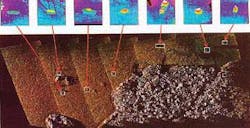Princeton Lightwave contributes technology to 3D imaging laser radar system
By Courtney E. Howard
CRANBURY, N.J. - Engineers at Princeton Lightwave Inc. (PLI), a manufacturer of optical semiconductor components and subsystems in Cranbury, N.J., are developing focal plane arrays (FPAs) for use in three-dimensional (3D) imaging flash laser radar (ladar) systems for military applications.
According to a two-year $3.5 million contract, company engineers are producing FPA modules with indium phosphide (InP)-based Geiger-mode avalanche photodiodes (GmAPDs). These single-photon-sensitive modules serve as the optical engines at the 3D imaging flash ladar systems’ core. 3D imaging ladar systems are central to current defense projects, such as the Jigsaw program sponsored by the Defense Advanced Research Projects Agency (DARPA) in Arlington, Va.
The 3D imaging FPA takes advantage of an InP GmAPD photodiode array (PDA), capable of detecting single photons at 1.06 microns. This PDA employs PLI’s GmAPD device technology, which takes into account such single-photon detection parameters as dark count rate, photon detection efficiency, and timing jitter. The PDA requires a specialized readout integrated circuit (ROIC) designed for the 3D imaging application.
The ROIC senses the GmAPD output current pulse on a per-pixel basis, assigning a time stamp indicating the time of flight between the launching of a short-duration ranging laser pulse and the photon-detection event. That per-pixel, time-of-flight information is translated into conventional ladar measurements, and the third spatial dimension is added to complement the two-dimensional image provided by pixel location in the detector array. PLI technology hybridizes the GmAPD PDAs and ROICs using flip-chip bonding, whereas an array of microlenses mated to the back-illuminated PDA chip achieve a high optical fill factor. All these processes combine to deliver military personnel valuable 3D image data, even in situations involving large source attenuation, says a PLI representative.
“By the time we complete this two-year development program, we expect to see product-scale demand for these sensors to provide 3D imaging capability in a variety of defense systems,” says Mark Itzler, PLI’s CTO and principal investigator for the program.
The GmAPD FPA technology has been demonstrated by MIT Lincoln Laboratory under DARPA sponsorship of the Jigsaw program. MIT Lincoln Laboratory is a federally funded research-and-development center managed by the Massachusetts Institute of Technology, primarily funded by the U.S. Department of Defense, and located at Hanscom Air Force Base in Lexington, Mass. The Jigsaw program first demonstrated the feasibility of using GmAPD FPA technology to create 3D images of objects that are camouflaged and obscured by forest canopy and netting, for example.
For more information, visit www.princetonlightwave.com.

